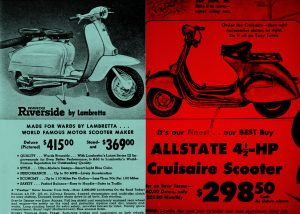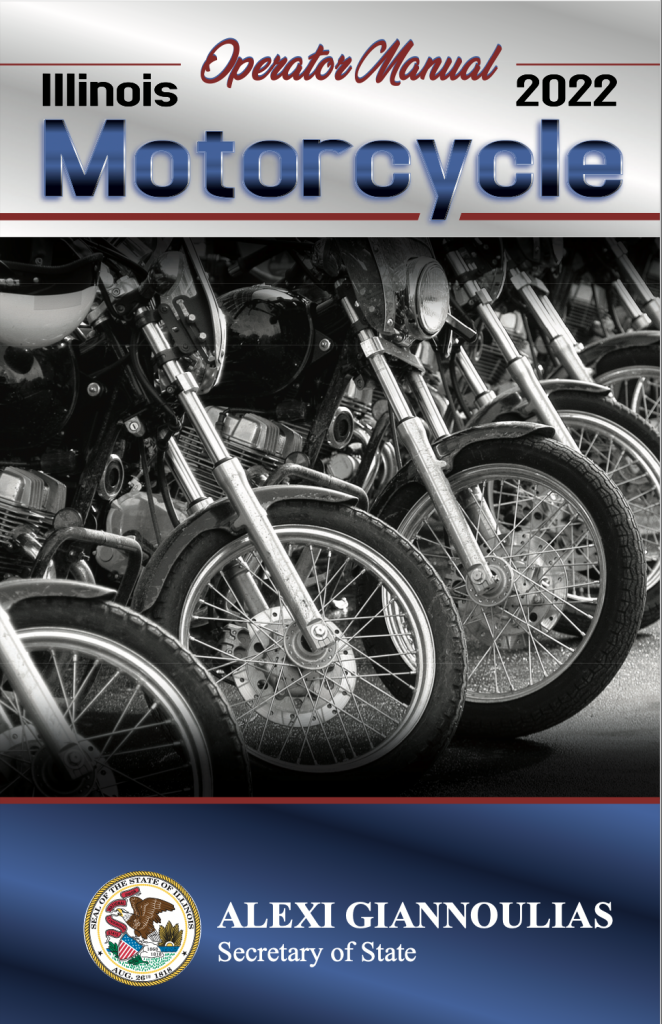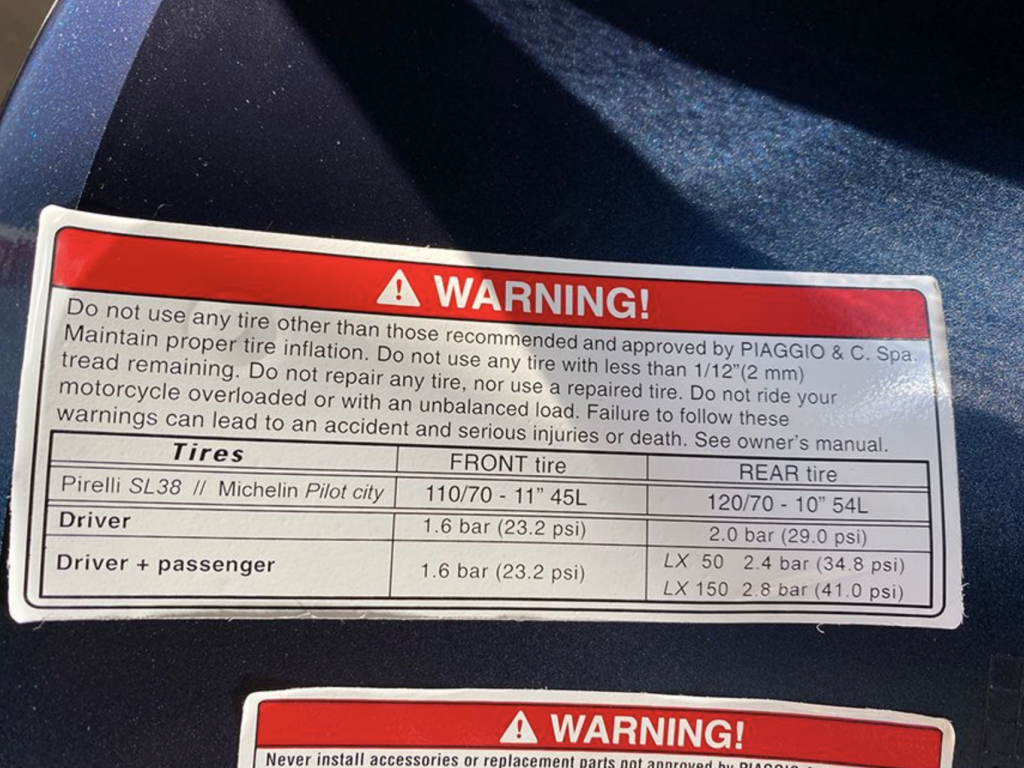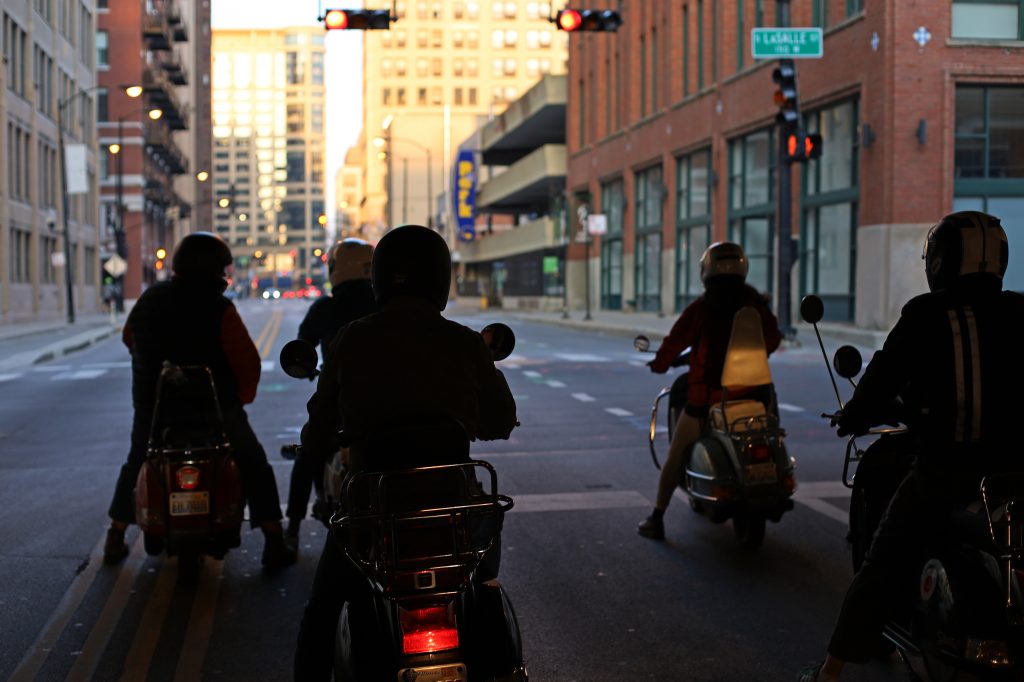
People are attracted to motorscooters for a variety of reasons. They’re fun, affordable, efficient, and convenient. Whether you’re just getting started with scootering, coming from the motorcycle world, or an experienced scooterist that’s new to Chicago, The Vespa Club of Chicago wants to ensure you’re well-informed before you head out into Chicagoland on two wheels. Scootering is a lifelong journey… learning what lies ahead will ensure you’re riding safely and legally, and having more fun.
Contents:
- Scooters and Scootering in Chicago
- Legal Requirements for Chicago Scooterists
- Learning to Ride
- Choosing a Scooter
- Buying New
- Buying Used
- Vintage Scooters
- Scooter Riding Gear
- Parking and Theft Prevention
- Riding in Chicago
- Tips from VCOA Members
- Maintenance
- The Social Side of Scootering
- Conclusion/Disclaimer
Scooters and Scootering in Chicago
Motorscooters aren’t nearly as popular in the United States as elsewhere in the world, but Chicago’s a hotspot. It’s surprising that scootering is so popular here. Our weather is not optimal, with a blazing-hot summer and a cruel winter separated by a couple rainy weeks we call “Spring” and “Fall.” Traffic and drivers are appalling. Chicago’s parking and traffic laws don’t do us any favors. And the expenses of owning and operating a scooter here are among the highest in the U.S.
Even so, scooters remain popular. You can credit our city’s devoted enthusiasts, active clubs, and supportive dealers for building a thriving community over many years.
Chicago Scooter History
Chicago is, in a roundabout way, the spiritual American home of Vespa and Lambretta scooters. Chicago-based Sears started importing Vespas (before Piaggio!) in 1952, first under their “Allstate” brand, and later (in 1966-67) with a blue “Sears” badge.
Sears’ competitor Montgomery Ward, also Chicago-based, sold “Riverside”-badged Lambrettas, starting in the early sixties.
A couple decades (and several importers) later, Vespa of Chicago on North Clark Street became a Vespa importer, offering parts, service and the “DASMI” line of accessories until Piaggio left the U.S. market in 1985. VoC was acquired in the nineties by Scooterworks. Scooterworks founder Philip McCaleb had a handshake deal with the Agnelli family (owners of Fiat and Piaggio) to become the national importer on their return, but Piaggio changed hands around that time, and established their own U.S. distributorship in 1999. In response, McCaleb started Genuine Scooter Co., importing the Indian LML Star (as the “Genuine Stella”) and the Taiwanese PGO “Bubu” (as the “Buddy”). With savvy marketing and branding, both models became wildly popular, and Genuine was as integral to re-popularizing scootering in America in the 21st Century as the reintroduction of the Vespa.
Legal Requirements for Chicago Scooterists
There are many responsibilities that come along with a scooter. The official “Illinois Motorcycle Operator’s Manual” is a great place to start. This booklet features all the information you’ll need to take your test and obtain your license. (You can pick up a printed copy at any Illinois DMV).
License/motorcycle endorsement:
In Illinois you DO need a driver’s license with a motorcycle endorsement to legally operate a motorscooter. (Yes, even 50cc scooters… see “Scooters vs. Mopeds and Electric Bikes,” below) This requires a written test (to get your learner’s permit), then a riding test to get the full endorsement.
There are two endorsement classes: “L” class (aka “Motor-Driven Cycle”) is for vehicles under 150cc; “M” (“Motorcycle”) is 150cc and above. The written test is the same for both classes, and the riding test is essentially the same, so (unless you’re under 18) even if you ride a smaller-displacement scooter, it’s smart to take the riding test on a 150cc+ scooter: you’ll then be licensed to ride any scooter or motorcycle!
Title/Plates/Registration
Motorscooters (both L- and M-class) require a vehicle title, motorcycle plates ($41/year) and annual registration (plate stickers). Be sure to register your scooter as the proper class, the plates are subtly different.
If you buy from a licensed dealer, they’ll submit the paperwork for your plates and title. If you buy from a private seller, be sure to get the title (with the “transfer of title” signed on the back) and a bill of sale (signed by both parties), or it will be very difficult/expensive to get a new title and plates.
Keep your current registration, insurance card, and city tag receipt (or, better yet, a copy) inside a waterproof baggie in your scooter. Do not keep the title (even a copy) with the bike, lock it up somewhere safe!
Antique plates are a bargain (they cost $30 and are only renewed every five years) but are only for 25+ year-old scooters and “may only be driven to and from an antique auto show or exhibition, service station or demonstration.” So if you ride often, it’s best to get regular plates or “Expanded Use” Antique plates (below)
Introduced in 2021 Expanded Use Antique Plates cost $23/year and allow you to ride a 20+ year-old scooter or motorcycle regularly between March and November. From December to February they are subject to the same restrictions as antique plates. Seems like a good deal if you don’t ride in the winter, honestly we just learned about these and will look into them more.
If you do buy a scooter without a title, there are ways to get one:
• File for a lost title at DMV. If the bike was originally titled in Illinois, and the bike wasn’t stolen or lost, it’ll work fine, but it’s slow, and could be a problem if the owner listed on the title decides they want it back.
• Pay a private title recovery service. Faster and easier, but it can be expensive.
• Vermont offered titles and plates by mail to non-residents for motorcycles older than 15 years or under 300cc without a title, but thanks to criminals abusing the system, this option was shut down on July 1, 2023.
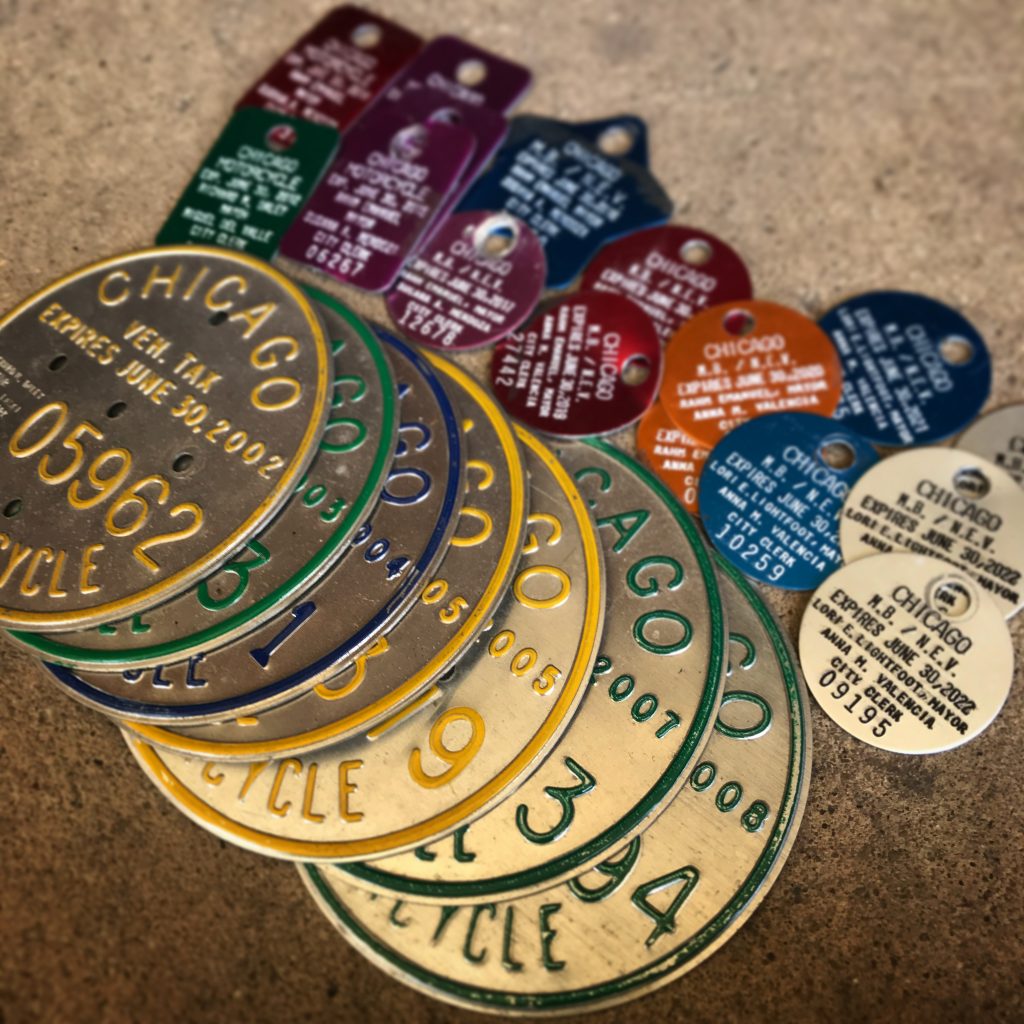
Chicago “Wheel Tax”
All Chicago residents driving a vehicle in Chicago must pay the “Wheel Tax.” For scooters, it’s a small metal tag that bolts to your license plate. Even the city doesn’t seem to have an official name for these things, they usually call it a “vehicle sticker” “city sticker” or “motorbike tag”. Others call it a “city medallion” or “parking sticker” – even though it’s not specifically for parking. It costs $45 annually, renewed every July. Even if you never park on the street, or if your scooter is registered at your parents’ house, if you live in the city, you CAN be ticketed or towed (even from a private lot) for not having one, and they’ll hit you for the back charges AND late fees for every year since your bike was titled.
There is one benefit to paying this $45/year: your city tag allows you to park on the street in any residential parking zone, which is pretty useful, especially in trendy neighborhoods or during events.
Protect your license plate, decal, and city tag!
• With many scofflaws riding untitled, unregistered motorcycles, legal plates are a hot commodity in Chicago, and are occasionally stolen. After applying your registration sticker to the plate, cut an “X” across the sticker with a razor blade so it can’t be peeled off in one piece, and mount the plate and city tag with anti-theft screws (that require a special tool).
Insurance:
Liability insurance is mandatory by law in Illinois. Considering the risk of theft, damage, and injury, comprehensive insurance is an absolute must, and be sure to include uninsured/underinsured motorist coverage. Despite the legal requirement to have liability insurance, more than one in ten Illinois drivers don’t, and that figure is surely far higher in the city. Many other drivers have a questionable bare-minimum policy, or may flee the scene of an accident.
Note that home/renter’s insurance does not cover motor vehicles, but bundling your scooter coverage with your home or auto policy can save money, as does parking in a garage, and not riding in the winter months. Policies vary wildly in features and price, so shop around.
Late-model scooters are generally insured for “blue book” replacement value. Some companies offer “stated value” insurance, where you choose the value and pay accordingly. It’s worth paying for more coverage for a vintage scooter, repairs to a beloved vintage scooter often add up to far more than its full replacement value). Some companies (notably Progressive) have recently stopped offering this for vehicles over 50 years old. For scooters older than 25 years, we recommend Hagerty Insurance, they are vintage vehicle specialists, and reasonably-priced. Be sure your coverage also includes your helmet, gear, and accessories and modifications.
Scooters vs. Mopeds and Electric Bikes
Some scooterists, and even dealers, will tell you that you can ride any 50cc scooter without a motorcycle endorsement. This is absolutely NOT true. An adult can ride a 50cc moped with a regular drivers’ license, but it must meet all four of the following criteria:
• speed attainable in one mile of between 20 mph and 30 mph.
• motor produces 2 brake horsepower or less.
• displacement under 50cc.
• does not require the operator to shift gears.
(Illinois law also describes a “moped” as “having pedals” and “capable of being pedaled like a bicycle.”)
Some manufacturers restrict their 50cc scooters to meet other states’ “moped” criteria, but these “no license” 50cc models generally do not meet Illinois’ criteria. In just about all cases, you DO need an L (or M) endorsement to ride a 50cc motorscooter in Illinois. If a salesperson tells you otherwise, don’t take their word for it, compare the specs to the criteria above.
Electric bicycles, scooters, and motorcycles are whole other beasts, and to be honest, it’s hard to figure out what the requirements are, as such vehicles are new to the market and the laws are still being written. Whatever you ride, be sure (before you buy) that you’re aware of the current laws, and be wary of what the manufacturer or salespeople tell you. Electric vehicles are a little outside our area of expertise, and we wouldn’t want to give you bad advice. Please do your own research and ensure you’re riding safely and legally.
What we do know is that any motorized vehicle (aside from “Class 1” e-bikes with pedal assist and a top speed under 20 mph, weighing less than 125 pounds) should stay out of Chicago bicycle lanes. And hey, why not get a motorcycle license anyway? It sure can’t hurt!
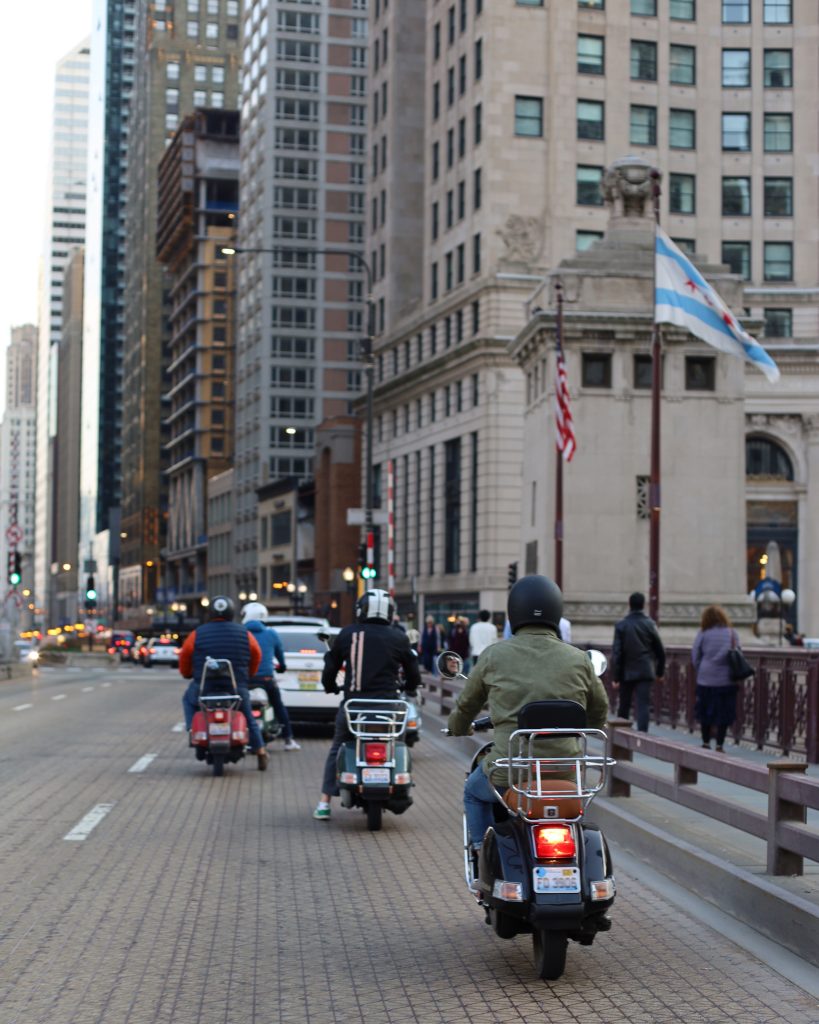
Learning to Ride
Riding a scooter seems pretty straightforward, but there’s more to it than common sense. There’s a lot to learn about the physics of the bike, road position, hazards, steering, braking, and situational awareness. It’s a lot of stuff you’ll never intuitively figure out on your own. The more effort you put into learning, the more you’ll reduce the risks. The Illinois motorcycle manual/study guide is a great place to start, but it’s only a start.
We recommend reading the book “Proficient Motorcycling” by David L. Hough cover-to-cover, then reading it again, then reading the sequels. There are always copies on Thriftbooks.com for a few bucks, or you can buy it for full price from the Man.
There are many other books, YouTube channels, and websites full of good motorcycle advice. Remember that pretty much anything motorcycle-related is applicable to scooters. There’s really not much difference between a motorcycle and a scooter other than the shifting mechanism and the rear brake location.
The Motorcycle Safety Foundation is the gold standard for motorcycle education. They offered a few “free” (small donation) classes but it was notoriously difficult to reserve a spot. As of Summer 2023, it appears MSF’s Northeast Illinois region is inactive, which is a huge shame, but they do list some private MSF-sanctioned classes, and you may have some luck finding MSF-sponsored classes downstate, or in IN or WI. Their website remains a fantastic resource.
Ride Chicago follows the general MSF curriculum and offers state-certified classes. Their classes are very reasonably-priced, and offered year-round. They are very scooter-friendly, even offering scooter-specific classes (Though, again, it doesn’t hurt to take your class — and test — on a motorcycle).
VCOA Chicago organizes occasional “new rider” meetups to teach group riding and practice drills (check our events schedule, or contact us if you’d like to meet up to practice) but we’re no substitute for a real class with an MSF-trained instructor.
However experienced you are with scooters and motorcycles, it’s essential to continue educating yourself, Re-read your books, read new ones, watch some videos, and take a refresher or advanced class regularly.
Choosing a Scooter
Scooter makes and models change all the time and it’s easy enough to find up-to-date reviews and comparisons online, so we’re not going to dig deeply into specific scooters, but rather look at the most common styles and displacements, then talk a bit about the importance of buying from a good manufacturer and importer.
Styles
While there aren’t official style designations for scooters, you’ll see a wide variety of styles to choose from. Some are sportier, often designed to look like sportbikes, while others are more conservatively designed. Some are very modern-looking, others are retro. Physical size varies quite a bit, as does displacement (see below). Obviously, your taste will dictate what scooters you’re attracted too, but be sure to consider practicality (especially ergonomics, maintenance, and storage!) along with aesthetics.
Displacement
The performance and general feel of a scooter isn’t entirely dictated by its engine size, but displacement is a good place to start. Consider the general platform; if a 150 and a 50 share the same frame, you might find the frame is balanced for both, or maybe the frame is designed for the 150 and a bit heavy and over-engineered for a 50cc engine (smoother ride, more reliable, possibly-frustrating performance). Alternately, you might find that the frame was designed for the 50, and the 150 is stretching the limits of the platform (white-knuckle ride, more power than you’d expect). Which is preferable? That’s a matter of opinion!
- 50cc: Most modern 50cc scooters are light, zippy, fun, and fuel-efficent. They’re generally adequate for short solo rides in the city, suburbs, or resort communities. You’ll hold up traffic on faster roads, which makes longer trips (and riding with a group) frustrating, and it’s asking a lot of a 50cc scooter to carry two American adult humans, or a lot of baggage.
- 75-125cc: These are generally a bit faster and more powerful than a 50cc, but not very common these days, aside from the various 125cc Honda Mini-Motos, which are all pretty great but still a bit underpowered for longer trips.
- 150-180cc: This has long been considered the “sweet spot” for scooters… small and manageable, but with plenty of power to keep up with city traffic, and big/fast enough to get a few hours out of town on arterial roads with a bit of luggage. They’re fine for shorter rides with two average-sized passengers. They are legal on the interstate, but pretty scary; you’ll be blown around by trucks, and get honked at, even in the right lane.
- 200-350cc: If you’re looking to ride longer distances, do some highway riding, carry a passenger comfortably, or are physically on the tall/heavy side, you’ll want to look in this range. The downside is the cost, size, and weight: as the engine and frame get bigger, they take up more space in your garage, and they’re a little less nimble around town.
- 400+cc: “Maxiscooters” edge into motorcycle territory, both in size and speed. They’re made for longer, faster road trips, and are more at home on the highway, loaded up with two riders and luggage. The riding position is downright luxurious (we call ’em “Barcaloungers”). They’re alright in the city, but the riding experience is very different from the zippiness of a smaller scooter.
Manufacturers
Being the Vespa Club of Chicago, we’re inclined towards the Vespa, but all that style, quality, and history makes it one of the more expensive brands. BMW is up there in price, too, but the couple models they sell in the U.S. are top-notch. Honda, Yamaha, and Suzuki are all top-quality, but a bit more affordable. Taiwanese brands like PGO (most Genuine models), SYM, and Kymco are known as a great value for the money. All these brands have good resale value, especially Vespa and Honda, and most have plenty of parts and accessories available.
Other brands aren’t as well-known in the United States. Vespa’s parent company also makes Piaggio and Aprilia scooters, though the former are getting harder to find in the U.S., and the latter don’t seem to be available in the U.S. anymore. Royal Alloy is a modern Lambretta-styled scooter that’s distributed by Genuine. You might come across used or gray-market scooters from Kawasaki, Gilera, Peugeot, TGB, Bajaj, Italjet, as well as vintage scooters made by dozens of long-dead marques, Many are worth considering, but if the brand has no active U.S. dealer network, you’ll be on your own for parts and service.
That still leaves many other brands, mostly manufacured in China for the lower end of the market. Some are worth considering, for instance Chicago Scooter Company is a less-expensive brand imported by Genuine, and SYM has a cheaper offshoot, Lance. Some well-known brand names (such as Benelli, Sachs, Schwinn, and even Lambretta) have been applied to Chinese scooters over the past couple decades, usually with disappointing results. Some of these cheaper scooters have a decent support network, but we’d argue the cheapest should be avoided, and the better ones are generally about the same price as a gently-used brand-name scooter. On top of that, it’s difficult to tell the good from the bad. They’re often identical in design, and built in the same factories. We do meet people who love their Chinese-made scooters, and of course we welcome all scooters and scooterists with open arms, but we’ve also met people who felt swindled and quickly lost interest in scootering. Some of the worst/cheapest models are flat-out unsafe. Caveat Emptor.
(Let’s be very clear that these observations are in no way a reflection on the people of China or Asia, please see our note about “‘Chinese Scooters’ and ‘Asian Restorations’.”)
Importers
While not as visible as the manufacturer or the dealer, your scooter’s importer is very important. Ensure that your manufacturer and dealer are connected by a reliable, accountable importer that supports their dealers adequately with scooters, parts, accessories, and technical training.
Resale Value (new scooters)
Like any motor vehicle, a new scooter will depreciate when you leave the lot, but a popular model from a well-established brand is going to have a much higher resale value than a no-name scooter. In fact, in the last few years, with high gas prices and a shortage of new scooters, used scooters often sell for surprisingly high prices. Of course, that will all change in a few years when gas is cheap again, and there’s a glut of scooters, and no demand. Vespas and Hondas seem to have the highest resale value, but never expect to get what you paid for it. (You’ll find folks trying to sell a five-year-old low-mileage Vespa GTS at MSRP arguing that they spent $500 on accessories and hardly rode it. That’s not how it works, they DO depreciate.)
Buying New
Your dealer is every bit as important as the manufacturer. Find a dealer that knows the scooters they sell inside-out, and is authorized for sales and trained for service. If they specialize in scooters, all the better (some motorcycle dealers sell scooters as an afterthought, while others are great). It’s a hard life for scooter dealers, the industry is very cyclical (no pun intended). If a dealer’s been around more than a few years, they’re probably a good one, because it takes a real love of scooters to keep a dealership open.
Local Dealers:
This list features current (as of Summer 2023) dealers that specialize in scooters that we’re aware of. We did not include most BMW/Honda/Yamaha/Suzuki dealers because there are many in the area, and they’re not difficult to find. If you’re looking for a specific brand, the manufacturer’s website is always the best place to check for a current dealer list, but always call ahead, the lists are not always up to date. (This list is not an endorsement, we’ve never been to some of these places)
Chicago:
Motoworks (BMW, Vespa/Piaggio)
1901 S Western Ave., Chicago
Scooterworks Chicago (Genuine/Chicago/Royal Alloy,
Kymco, Benelli)
5410 N Damen Ave., Chicago
Second City Scooters (SYM, Lance)
5578 N. Lincoln Ave., Chicago
City Scooters (Wolf, Lifan, Ice Bear, Hyosung)
6320 N. Milwaukee Ave., Chicago
Suburbs:
Arlington Motor Sports
(Vespa/Piaggio, Genuine/Chicago, Kymco, SYM, Lance)
1020 W. Northwest Hwy., Arlington Heights
Vespa Downers Grove (Vespa/Piaggio, Genuine)
2101 W Ogden Ave., Downers Grove
Midwest Action Cycle
(Vespa/Piaggio, Genuine/Chicago, SYM, Lance, Scootstar)
2463 Vista Dr., Lake Geneva, WI
The Tool Store (Ice Bear, Peace, Tao Tao, Yongfu)
4529 S Harlem Ave., Forest View
MSRP and Haggling
Scooter dealers honestly make very little money on scooter sales. Unlike most industries, where the standard is 50% retail markup, a scooter dealer’s “take” is sometimes less than 20% of the MSRP. It’s rarely more than 30%. They also must add charges for assembly, freight, taxes and title/registration charges. On top of that, they’re often paying financing on the bikes they’re “flooring” until sold, and recently, some shippers have been adding a shipping surcharge, holding deliveries for ransom. These additional charges are legitimate expenses the dealer needs to cover. Combined, they can add up to more than $1000, which is often more than the dealer’s profit margin on the scooter.
So it’s worth trying a little bargaining, but don’t expect big results, there’s usually not much wiggle room in the pricing. Even if you’re a good negotiator, your “out the door” price will almost certainly be a good deal higher than MSRP. An honest dealer will be very clear and up-front about this, hopefully listing the MSRP and the “out the door” price on the tag (though, sadly, rarely on their websites or ads!).
Don’t expect a deal on the most popular model in the springtime when people are lined up outside the shop. If you’re looking for bargains, visit the shop on a January weekday morning when there’s snow on the ground, and ask what they’re trying to get rid of.
Avoid financing if at all possible. It’ll cost you much more in the long run, and the dealer rarely profits from financing. You’re making the dealer work harder, and making a bank richer.
If scooter dealers only sold scooters, they wouldn’t be around long. Thankfully, service and accessories are more profitable. Support your dealer by buying parts and accessories through them rather than the big online retailers. (All the big online shops are secretly run by the very same parts distributors that sell to your dealer, they’re purposefully undercutting their own dealers. It’s a gross industry.) You’ll soon see that the best scooter dealers generously support clubs and rallies, and that many dealers are scooter fanatics just like us, trying to make a living in a very difficult market.
Expenses to consider:
The cost of your scooter will probably be your biggest expense, but there are lots more:
Essential: (* mandated by law)
Scooter ($0-10,000+)
Taxes*/dealer fees* (sometimes $1000+)
Title*, plate*, and registration* ($196 on purchase, $41 annually)
Chicago “wheel tax”* ($45 annually)
Liability Insurance* (varies by policy)
Collision/un/underinsured insurance
Oil changes/maintenance (ask your dealer)
Expendable parts (tires/brakes/battery, etc, ask your dealer)
Gas (and 2-stroke oil, if needed)
Eye Protection* ($20+)
Helmet ($150+)
Gloves ($30+)
Armored jacket ($100+)
Trickle charger ($15+)
Optional/situational
Chain/lock ($25+)
Tracking chip (varies, may require annual fee)
Storage/parking/garage space (varies)Accessories (windscreen, topbox, rack, crashbars, etc)
Performance mods/upgrades
Parts/repairs (esp. for used/vintage bikes)
Cover
Winter storage (annual, ask dealer)
VCOA membership ($35 annually)
Roadside Assistance (included w/VCOA membership) or towing/transportation
Trailer (purchase/rental/storage, including hitch and insurance)
Buying Used
Many Vespa Club of Chicago members have spent years hunting down rusty Vespas in barns and crawl spaces throughout the Midwest, so it still seems kind of crazy that you can just walk into a nice, clean, well-lit building, hand over a few thousand dollars, and ride home on a brand new scooter — with a warranty — and not even have to stop at the DMV. That all sounds very nice, but some of us are cheapskates. Some of us like a challenge. Some of us like to ride things you can’t buy at a store.
For people like you, we’ve prepared the Vespa Club of Chicago Guide to Buying a Used Scooter.
Vintage Scooters
If you’re interested in a vintage scooter, you should know what you’re getting into, but don’t let it scare you away. Classic European scooters like Vespas and Lambrettas are most commonly 125-200cc, with a simple 2-stroke engine that requires 2-stroke oil to be mixed with the gas. Earlier models require the oil to be measured directly into the gas tank, later models have a separate oil tank. Unlike modern scooters, most have a manual (usually 4-speed) transmission, but it’s easily learned. They require a bit more maintenance, and it’s hard to find anyone to work on them, so owning one requires a modest set of tools and a little mechanical aptitude. If that all sounds good to you, go for it! There are a variety of models, but if you’re new to vintage scooters, it’s best to stick to the more common and standardized models made after 1960 (Vespa) or 1962 (Lambretta, including the Spanish-made “Serveta”) There are lots of resources for the repair and maintenance of these scooters, and parts availability/quality/variety improves every day.
Another option is a scooter based on the classic design of the Vespa, like the Genuine Stella. Many companies around the world built classic Vespas under license and continued making them years after similar Vespa models were discontinued. 2-stroke LML Stars (Genuine Stellas) and Bajaj Chetas are nearly identical to a classic Vespa, with mostly interchangeable parts, but others (the 4-stroke and/or automatic models) are far more proprietary, and less desirable because of a dwindling parts supply.
There are many other brands made around the world in the last 100 years — Fuji, Zündapp, Heinkel, NSU… — but parts and resources are scant, especially in the U.S.
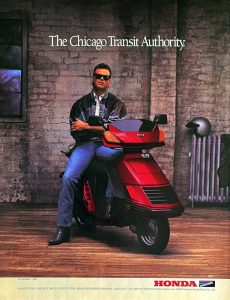
All that said, don’t forget that even scooters from the late 1990s are eligible for vintage motorcycle plates! Automatic 4-stroke Hondas and Yamahas from the eighties are obviously “Vintage” by now. They were super-common, nearly bulletproof, and most models were made for years with minimal changes so parts are easy to find.
Some scooters were built to last, and/or are still made to essentially the same specs today, others are best avoided. If it was a popular model with a common motor, and the manufacturer is still going strong, parts and service might not be a problem at all. If it was an oddball model that didn’t sell well, and the manufacturer or importer is long gone, think twice, though even in that case, if it’s a great price and runs reliably, it might be worth it for a couple good years of service.
Servicing and restoring scooters can get pretty expensive, but it’s still a small fraction of what it costs to maintain/restore a vintage automobile or even a motorcycle, and everything you need is pretty easy to find, so a one-cylinder, two-stroke scooter is a great entry point into the world of collecting and restoring antique vehicles.
“Chinese Scooters” and “Asian Restorations”
Thousands of vintage Vespas and Lambrettas were very poorly restored in Asia over the last 25 years and exported to the U.S. They often look beautiful in photos or even from a couple feet away, but closer inspection makes it clear they’re cobbled together from thoroughly ruined bodies and engines, and cheapo parts and accessories. They turn up every day on every auction/sale/listing site and even at some dealers. Do vigilant research, and don’t convince yourself that you can ‘fix it up,” any longtime scooterist or professional shop can tell you from experience that they’re too far gone and useless for anything but a decoration at an Italian restaurant. Google the (unfortunate) term “Vietbodge” and you will find plenty more info, please heed it.
This (and our warning about some modern Chinese-made scooters, above) is absolutely not a reflection on the people of Asia. Scooters are a way of life in Asia, There’s an amazing vintage scooter scene in most Asian countries, and millions of scooter enthusiasts just like us. Their domestic models and some export models are great, and most major manufacturers make at least some of their scooters and many of their parts in Vietnam and China. But there are enough unscrupulous manufacturers, importers, and restorers, that it would be negligent to not mention the problem in this document. These restorations, and many new cheapo Asian export scooters, are flat-out dangerous.
By the same token, be wary of online scooter parts from eBay sellers and unfamiliar shops. Most cheap parts on eBay are very poorly made, and sometimes bootlegs of well-known brands. Buy parts only from a reputable and respected shop. High-quality parts are absolutely worth what they cost.
Resale Value (Vintage scooters)
After depreciating for years, older scooters eventually start to appreciate, but before you dump thousands of dollars into restoring and repainting a scooter, be aware you’ll probably never make your money back unless it’s a very desirable model and the work is immaculately done to concours standards. You might love your cutdown Vespa loaded with German performance parts and masterfully airbrushed Gilligan’s Island murals, but no one’s going to pay you the $12k you sank into it. But, by all means, if it makes you happy, go for it, (and insure it for “stated value”). It’s also worth considering the age of enthusiasts. 20 years ago, Cushman and other pre-war scooters were selling for $10K plus, but as their enthusiasts pass away, their value is plummeting. Vespa and Lambretta prices are at an all-time high as the ‘aging mod’ demographic finally has the spare income and time to build a collection, but their value is likely to drop eventually. Even 80s mopeds have become pretty expensive. If you’re in it for the money, start hoarding the next big thing before everyone else does.
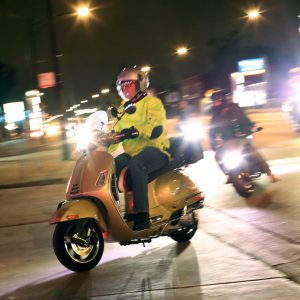
Scooter Riding Gear
Helmets
Illinois is one of only three U.S. states with no motorcycle helmet law, even for children. “Freedom” is great and all, but we really like your brain and your face, so please wear one. A scooter is just as dangerous as a motorcycle, and however experienced you are, there are still huge risks.
From day one, get a quality full-face helmet and always wear it. You’ll get used to it in no time… you’ll feel naked without it.
There are many helmet standards. “DOT” is the minimum U.S. standard, but it’s a very weak standard to begin with, and it works mostly on the honor system. Ultimate Motorcycling has been reporting for several years that that almost half of DOT-labeled helmets on the market don’t even pass the not-very-stringent DOT test, and hardly any recalls are issued or other action taken.
So, please read up on various helmet safety standards (DOT, Snell, ECE, SHARP, FIM, etc) and look for the standard(s) you’re comfortable with. (Read more from Wikipedia and Ultimate Motorcycling.)
You can find a pretty decent full-face starting around $130. Remember that safety certifications and a perfect fit are more important than price or brand name. In general, more money will buy you a better-made, more comfortable helmet with more features. Cheaper helmets might be safe, but not terribly comfortable. Comfort, (along with removable/washable padding, good ventilation, reduced noise, anti-fog/auto-tint visors, and communication pockets) is all worth the investment if you’re spending a lot of time on your scooter.
Different brands have wildly different sizing and general shapes, so try on as many as possible to find a brand/model/size that fits your head just right. Then support your local shop. Don’t waste the salesperson’s time trying on helmets, then go order one from Amazon in the parking lot to save $28. On the other hand, don’t be pressured to buy a helmet you’re not 100% happy with.
Prices drop over the winter before the new models come out, but popular sizes and colors are often hard to find.
Again, don’t settle for less than full-face. Modular helmets are generally as safe as a solid full-face (when worn with the front locked down), and some people with glasses like them, but they’re often bigger, heavier, and not any less awkward to put on.
Before buying a helmet, check if it fits in your topbox or underseat storage area, or at least that the straps/buckles fit into your bike’s helmet hooks.
Helmets are offered in a wide variety of colors including black, matte black, anthracite, charcoal, and blacktop. They might offer white, if you’re lucky, and a few patterns borrowed from a 1990s recreational vehicle. We wish they made more bright solid colors, for better visibility. It never hurts to add reflective decals, or one of those cool LEDs that automatically lights up when you’re braking.
Retro-looking helmets are appealing, but are often less comfortable (and sometimes less safe!) than boring modern designs. If your friends are going to hassle you for being safe, make new friends. Get a safe, comfortable full-face helmet now, buy a pretty one for parades and photo shoots later.
Always be gentle with your helmet, dropping it or banging it around can internally damage it, and reduce its effectiveness.
Manufacturers say to replace helmets every 5 years, though that’s flexible, depending on how much you ride and how well you care for it. If it’s had a long/hard life or was in any sort of collision, replace it.
Keep your visor clean, and replace it if it gets scratched up. A tinted visor is great in the sun but don’t wear it at night. Read up on various anti-fog strategies (factory coatings, sprays, and Pinlock) and their related pros and cons. Note that some visors (even clear ones) are polarized, and may clash with polarized sunglasses, creating a psychedelic effect which is not something you need to deal with, in traffic.
Other gear
Eye protection is mandatory in Illinois. If your helmet doesn’t have a visor, you MUST, by law, wear glasses or sunglasses to keep cicadas and wasps out of your eyes. Cicadas and wasps will still get in your ears and mouth. Rain, hail, construction dust, and CTA bus exhaust will still get in your eyes. A full-face helmet prevents all these problems, far better than sunglasses.
Gloves are not legally required, but are essential. Even the gentlest spill can turn your hands into hamburger meat, and your grips can give you blisters on long rides. A $30 pair of motorcycle gloves will keep your paws safe and comfortable. You may want a lighter, ventilated pair for warm weather, and heavier gauntlets for colder weather.
Equally important is good footwear with a reasonably thick, grippy sole and protection for your ankles and toes. If you slide on concrete at 30mph, flip-flops or All-Stars will grind away like pencil erasers, and your toes will be next. Even if your bike falls over while parking, or if you put your foot down wrong at a light, it can really mess up your foot.
We also highly recommend an armored jacket with armor in the shoulders, elbows, and back Make sure it fits snugly, with the armor aligned where it belongs. A mesh armored jacket is lightweight, surprisingly breezy in summer, and helps prevent sunburn, and you can wear a parka over it in colder weather.
Next up is pants… you should probably wear some. Jeans are maybe not THAT much safer than shorts, but anything between you and the ground is nice. Armored pants or kevlar-stitched jeans are best, but maybe impractical for a short commute.
For all your gear (and your scooter!), bright-colored, hi-viz, and/or reflective material will make you more much more visible to drivers than black. And black is crazy-hot in the summer. Yet manufacturers (and apparently consumers) sure do love black. Maybe wear a hi-viz reflective vest over all that black gear?
Safety-minded motorcyclists use the phrase “ATGATT,” all the gear all the time. We sometimes convince ourselves to gear up less for short casual rides and more for longer adventures, but gear can’t help you if you’re not wearing it, and you’re at risk whenever you’re on two wheels. Remember that most collisions and spills happen near home… because you’re most commonly riding near home.
Parking and Theft Prevention
Parking in Chicago
In Chicago, all traffic and parking rules that apply to cars also apply to scooters. You may not park on the sidewalk, or at a bicycle rack. You must pay full price (with the parking app or at a meter using your license plate number) on metered streets.
Here’s the City of Chicago website and a brochure about scooter parking in Chicago.
If you’re displaying your “city tag,” you are welcome to park on streets with zoned neighborhood parking. This is super-useful during sporting events and festivals, or in busy neighborhoods. Riders without city tags may not park in these zoned residential parking/event zones, even if they live there. (If you do live there, you should have a city tag!)
When parking along a curb, your scooter must face the street, perpendicular to the curb. Don’t squeeze into exceedingly tight spaces, cars need room to get in and out. Ensure that any parked vehicles near your bike will see you when they pull out. Look out for bicycles when entering or leaving a parking space.
If you’re in a parking lot or garage, park towards the outside of the space, facing out, so drivers don’t think it’s an empty space. It’s sometimes OK to share a space with another scooter or motorcycle, but leave plenty of space between them. Some parking garages forbid scooters and motorcycles, but that’s becoming less common as they realize they can charge you as much as a car. Here’s a (very short) official city list of locations that offer discounted scooter/motorcycle parking
Yes, sure, in some areas/situations you can get away with things, but you do NOT want to get towed. The city will throw your bike on its side on a flatbed and you’ll spend a whole day at 701 N. Sacramento digging through piles of burnt-out sportbikes to find it. And that’s if the city gets it, private companies are worse. And then there are infinite fees for every city tag and plate sticker you didn’t have since the day the bike was titled. Keep it legal, or you’ll regret it.
Winter/Long-term storage.
Most dealers offer a winter storage package (and you can have your annual service done while it’s there). If you have a a garage, we have a guide to winter storage here on the VCOA-Chicago website.
If you store your scooter in a space where humans or animals live, be sure to drain the gas!
Theft Prevention
If someone really wants your scooter, they’ll find a way to take it. If you have good comprehensive insurance, you won’t have to lose sleep over it.
Aside from that, anything you can do to make your scooter a less-attractive target will help prevent theft.
Two humans can lift a scooter into a van or pickup truck in seconds. Locking it TO something with a chain is always a good idea, but rarely practical with street parking. If you’re riding with a friend, you can chain your bikes together when parking. Always wrap the chain around the frame or a wheel, and don’t leave any slack. Don’t lock to crash bars, luggage racks, fences, or anything else that can be cut with a hacksaw in a couple minutes.
Avoid leaving your scooter in the same visible spot everyday/night. If you don’t have a garage, rent space from a neighbor, or at least wheel it into your yard, out of sight, and keep it covered (maybe don’t use a shiny new Vespa-branded cover) and chained up.
Keep your steering column, glovebox, seat, and top box locked. Don’t leave anything super-valuable in your topbox, glovebox, or underseat storage. They’re reasonably secure, but (as you’ll find out when you inevitably lock your keys inside), they’re hardly impenetrable.
Do not leave your keys in or near the bike. Don’t label the keys in any way that would be helpful to a thief. Always keep a backup set somewhere safe, replacing locks is expensive, especially the ones with electronic security chips.
Speaking of electronic security chips, hiding a satellite GPS tracker in your bike is a great idea, but hide it well, and don’t advertise that it’s chipped. Bluetooth trackers are far less useful than true GPS trackers for multiple reasons; AirTags, for instance, have an anti-stalking function that will actually notify the thief, and allow them to disable tracking.
If your bike is stolen, contact the authorities, do not confront thieves. You have insurance, don’t risk your life over a stolen scooter.
Riding in Chicago
Chicago-specific tips:
Don’t split lanes or pass stopped cars on the right at red lights and stop signs. It’s illegal, rude, and dangerous.
Look out for metal plates, exposed trolley tracks, construction debris, missing manhole covers, potholes, railroad crossings, and especially “frost heaves” which create an almost-invisible ramp, usually near the curb in intersections. You might not have ever heard of a frost heave before, but when one launches you two feet into the air, you’ll start watching out for them.
Riding over a grated bridge feels terrifying, but you’re more in control than you’d think. Look ahead, follow your course, and try to relax.
Be aware of high winds and gusts, especially where buildings create a “canyon” with ridiculously strong crosswinds.
Riding in moderate rain and light snow is alright if you prepare for it and adjust your braking and steering accordingly. Most scooterists avoid the roads if there’s any chance of ice. Braking and steering on ice is very difficult, even with lots of experience.
Be prepared for sudden ridiculously loud noises and falling sparks when riding under El tracks. Also watch for drivers weaving in and out of the pillars, and try to avoid the ‘strobing’ effect of the sun through the tracks.
Be careful when you ride for the first time somewhere with hills and curves. Even if you’ve been riding in Chicago for years, nothing will prepare you for steep hills or sharp curves on the edge of a cliff.
Lower Wacker is terrifying by yourself, but really fun with a group.
Develop good situational awareness. It’s important to remember the difference between awareness and paranoia. Yes, carjackings and gun violence are in the news. Yes, there are questionable neighborhoods, but if you keep your eyes and your mind open, you’ll be OK. Yes, there are maniacs out there. There are plenty of maniacs int he suburbs and rural areas too. Don’t be that paranoid suburbanite who power-locks their doors and rolls up their windows when they cross Harlem Avenue.
Things you thought you could do on a scooter, but absolutely can’t, sorry:
Ride without a motorcycle endorsement
Ride without insurance, title, or plates.
Split lanes
Effortlessly glide through traffic
Ride in the bike lane
Ride/park on the sidewalk
Park at a bike rack
Park for free in a metered zone
Park anywhere you like
Find free, safe parking in the Loop
Ride in a miniskirt and high heels
Have carefully-styled long hair
Carry a passenger on a 50cc
Carry more than a couple bags of groceries
Throw it in the trunk of your SUV to take to the lake house
Ride home from the bars
Bicycles and Pedestrians
For the love of all that is holy, don’t ride in bike lanes, or on the sidewalk. Again, you’re following all the same laws as a car.
A motorcyclist or scooterist ignoring the right of way or safety of cyclists or pedestrians is the peak of hypocrisy. You’re expecting drivers to keep an eye out for you, so show the same respect for pedestrians and bicycles, especially when changing lanes, turning, parking, etc. If you do need to pass through a bike lane or go on a sidewalk to get into a parking space, kill your engine and walk the scooter.
Crosswalks
At a crosswalk without a light or stop sign, you are required to stop if you see a pedestrian entering the street. Hardly anyone in Chicago actually does this, which is terrible. Police do often stake out these crosswalks to give out tickets. Please stop, and look out for the car behind you, who probably has no intention of stopping.
Red Light Cameras and Safety Zones
If you drive already, you know to watch out for these. If you don’t, learn where they are. We like to promote safe, law-abiding riding, but honestly, most of these feel like baited traps to raise cash for the city. If you do get a ticket, pay it or contest it, but don’t ignore it, it’ll come back to haunt you.
Road rage and near-misses
If you ride long enough, you’ll encounter “near-misses,” which are occasionally due to your own lapses, but are more often the fault of a distracted or aggressive driver. The most important thing to remember in such a situation is, do not retaliate or antagonize the other motorist. There’s no telling what’s going on in their world and they’re likely to react with wildly disproportionate actions. We and our friends have been assaulted or had a gun waved at them for casually flipping off a distracted driver. Don’t start a fight, just catch your breath and move on.
Afterwards, don’t distract yourself by replaying the scene over and over in your mind. After a dramatic incident, get a safe distance from the situation, then pull over to a safe spot and calm down before riding again. Riding while you’re “wound up” is never a good idea.
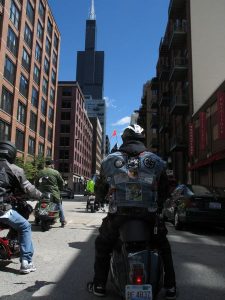
More Tips from VCOA-Chicago Members
Scooter won’t start? Don’t panic, make sure your key is set to ‘ignition,’ the kill switch is disengaged, and you’re holding the brake lever as you press the starter.
Don’t forget to click-off your turn signals after the turn. (Some of us who’ve been riding for 30 years still have a hard time with that.)
Don’t assume “How hard could it be!?“
Don’t rev an automatic to 6000 rpm, then drop it off the stand.
Don’t Armor-All your grips, seat, or tires.
Keep your scooters(s) titled, plated, city-sticker-ed, and insured at all times. It’s a drag — and expensive — but it’s part of owning a scooter in Chicago. If you do get pulled over or towed, you will waste an entire day and hundreds of dollars in tow charges, fines, and late fees to get it back. Worst, it’s likely to be casually thrown on its side on the tow and at the yard.
Riding with a passenger or a lot of baggage is a whole different world, practice in a parking lot before hitting the open road, and account for the added weight when turning and braking. Don’t overload your bike. Keep the load balanced and secure.
Your scooter WILL get dinged up. You might as well just hit it with a crowbar in the showroom, and get it over with.
A cupholder seems like a good idea…
If you have both manual and automatic scooters, never forget which one you’re riding. Grabbing your rear brake thinking it’s the clutch in a panic situation is not great.
You know about “the wave” right? It’s basically a peace/scout sign pointing diagonally down with your left hand. Some motorcyclists like it, some will sneer at you for acknowledging them, which makes it even more fun. Some scooterists do it, some don’t. If you’re in a situation that requires your full attention, don’t wave, it’s not a big deal. On a vintage scooter, when your left hand is occupied with shifting or signaling a turn, a polite nod will do nicely.
You’ll find that people seem to have no problem taking photos of, touching, climbing on, letting their kids climb on, or moving your scooter.
At every gas stop and stoplight, a colorful weirdo will corner you and tell you about how he (it’s always a he) used to own one. Smile and nod. You will forever be asked “How much did it cost?”, “How fast does it go?”, and “What year is it!?”. You will soon develop an arsenal of amusing answers.
Don’t ride when you’re very tired, angry, or otherwise distracted. Riding requires your full attention. In fact, one of the best things about riding is forgetting about everything else to focus on riding.
We do meet up at bars, rather often, so if you’re in the mood to drink, don’t ride, take the bus and meet us there, that’s fine. I do it all the time. If you do end up drinking too much, leave your bike and pick it up in the morning. Or ask around, someone will be happy to help you get it somewhere safe, rather than letting you ride it home drunk.
Maintenance
Scooters are happiest when they’re ridden frequently. If you ride often, it’s less likely things will go wrong, and it’s far more likely you’ll notice (and address) minor issues before they become big problems.
The two most common scooter mechanical issues are both a result of disuse:
Batteries:
The biggest drain on your battery is the starter. If you’re firing it up frequently without riding long enough to charge it back up, it will eventually be too low to start the scooter. Leaving the scooter unridden for long periods also drains the battery. For these two reasons, you’ll want to keep your bike plugged into a trickle charger when not in use. Unlike a regular battery charger, the trickle charger monitors the battery, adding a slow, small charge when needed to extend the life of the battery. Without it, you’ll be buying an expensive new battery every spring. With it, you can expect a battery to last a few years. By the way, a name-brand battery is worth the investment; many cheaper batteries simply don’t last as long.
Carburetors:
If your scooter has a carburetor, every time you park, the remaining gas in the float bowl and other parts of the carb will evaporate, leaving residue. Over time this builds up and eventually will clog up one of the carb’s many tiny air/fuel passages. If your fuel tap or float needle leaks a bit, the problem will get much worse. If your scooter is running unevenly or won’t hold idle, the problem is almost always a clogged carburetor. Learning how to remove and clean it is useful (there are lots of YouTube videos) but preventing it is even better. Be sure your fuel filter and air filter are clean. Vintage scooters have a fuel tap that can be closed, if you’re putting the bike up overnight or longer, close the tap as you approach your destination and let all the gas run out of the carburetor. The engine will die once it’s emptied out (if not, you have a leak!). Modern scooters don’t generally have a fuel tap, but it may be a good idea to add one. Fuel additives may help, too, but again, the best way to keep your carb clean is by riding frequently, or buying a scooter with electronic fuel injection.
Oil Changes, tires, and other maintenance
Keeping your scooter properly serviced (and clean!) will ensure it serves you well for many years. Check the owner’s manual to see when oil changes and other maintenance are due. Most routine maintenance is pretty simple if you have the right tools, space, and time to work. Some people take to it naturally, others know themselves well enough to pay a shop to do it, which might be a good idea, especially if your bike is under warranty. We’ve written up some tips for aspiring scooter mechanics here. Bigger projects, like tubeless tire changes and valve adjustments, require more experience and special tools and are best left to someone with experience.
Check your tire pressure often. A small variation in pressure can have huge implications in traction and handling on a scooter. The correct pressures will be listed in your manual or on a sticker on your scooter (not on the tire!). Replace tires at the indicated mileage, or if they appear cracked, damaged, or worn. Check the manufacturing date on tires, if they’ve been sitting on a shelf in a warehouse for a decade, don’t use them, if they’ve been on your bike for several years, replace them.
Tools and Spares
Aside from your well-stocked toolbox at home, always carry any tools and spare parts you might need on the road. At a minimum, replace the janky tools that came with your bike with quality tools. What you carry depends on your bike, how far you’ll be from home, and how comfortable you are repairing it, but we’ve put together some basic guidelines here.
Roadside Assistance
VCOA offers roadside assistance as part of our membership fee. Some insurance companies and AAA do too, always keep your info (and/or a list of local motorcycle transport companies) in your wallet AND in your bike.
If you’re a VCOA member, you’ll need the phone number and your member code, more info here.
Transporting your Scooter
Eventually, you’ll want to transport your scooter a long distance. Maybe it’ll need repair, or you’ll want to take it on vacation, or attend a distant rally. Most scooters will fit side by side in a pickup truck (with the tailgate down) or in a small utility trailer. Consider the weight of the bikes and trailer and ensure your tow rating, hitch class, and tongue weight are all up to the task. Be sure the bikes are tied down properly and balanced over the trailer axle, with slightly more weight to the front.
Tiedown points/methods vary by scooter and vehicle, and there are many ideologies regarding best practices. The first time you do it, ask for help, or look for videos on YouTube.
If you use a “Versa-haul”-type carrier, confirm that the weight rating, your hitch class, and especially your tongue weight are all rated appropriately.
Always use a tongue lock AND a hitch lock to prevent trailer theft. If you’re leaving bikes on a trailer overnight, be sure to lock them securely to the trailer frame.
Do not cover trailered scooters while you’re driving. The tarp or cover flapping around will do far more damage than rain or bugs.
If carrying a scooter in a van or other enclosed vehicle, drain the gas and leave your windows open, gasoline fumes in an enclosed space are very dangerous.
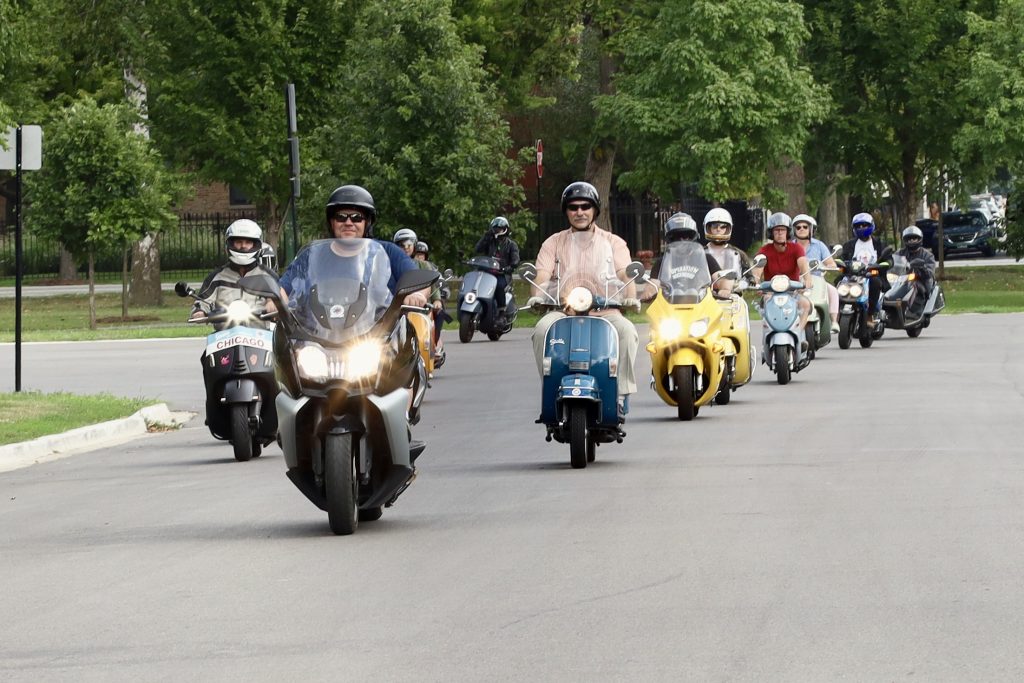
The Social Side of Scootering
Since there have been scooters, there have been scooter clubs. America has hosted a community of dedicated scooterists since before WWII, when American-made scooters like the Cushman, Salisbury, and Moto-Scoot ruled the roads. Soon after the Vespa was introduced in 1946, European Vespisti organized into clubs to host rides, races, tours, mechanical co-ops, and other events. As the Vespa became popular here, the American Scooter Club (1956-1960), Vespa Club U.S.A. (1957-1961), and other clubs copied the European model, organizing local chapters, planning local and national events, and publishing club newsletters and magazines.

Vespa Club of America
Vespa Club of America (VCOA) was founded in 1992 as the spiritual successor to the long-defunct VCUSA. It’s America’s largest and longest-running national club, and the U.S. affiliate of Vespa World Club, Piaggio’s official association. The VCOA organizes Amerivespa (the U.S. national rally), VCOA Vintage Days, Vespa Parade Day, and more. Vespa Club of Chicago (formed in 2019) is one of VCOA’s first and largest local chapters.
It’s exciting to be part of this huge international network of Vespa clubs. While most Vespa clubs around the world limit membership to Vespa riders, we welcome all marques, vintage and modern, to celebrate the diversity of scooters, scooterists, and scootering in America.
Many scooterists aren’t aware this scootering community exists. We’d love for you to check out a few events and see what we’re all about. Vespa Club of Chicago monthly meetups welcome all scooters and scooterists, including non-members and prospective scooterists. We hope you’ll agree that scootering is more fun with friends, and that the national club is worth supporting. Aside from friendship and events, VCOA offers local and national club patches, newsletters, gear discounts, roadside assistance, and more. If you enjoy our events, or find this guide useful please join the VCOA and select “Vespa Club of Chicago” as your local chapter.
Other local clubs:
Other local clubs include Chicago Vespisti, Mayday SC, a chapter of the national Lambretta Club, a Ruckus group, Scoot Jockeys Chicago, Second City Scooter Society, and some moped and minimoto clubs. Some are more active than others, some are open to the public, some are close-knit groups of old friends. Most of these groups overlap in membership with VCOA and work together to plan the local Slaughterhouse rally. Getting involved with VCOA or Slaughterhouse is a good way to meet people in all these clubs.
Types of Events:
A group ride could be a couple friends getting together for an impromptu ride, or hundreds of riders at a national scooter rally. Usually, it’s somewhere between those two extremes, with riders meeting up at an agreed-upon time and place, with a route in mind. Arrive on time with a legal, reliable bike, gassed-up and ready to go. Often there will be stops for food or photos.
Please read our guide to riding in a group before joining a group ride. Attending a monthly VCOA-Chicago meetup is a good place to learn. If you’re new to group riding, let us know when you arrive so we can talk you through things. We also host occasional meetups specifically for new riders. If you don’t see one on the schedule, ask, and we’ll make it happen. A few smaller group rides will give you the experience you need for a bigger group ride, like Slaughterhouse or Amerivespa.
A scooter rally is a bigger event, sometimes a full day, but more commonly an entire weekend. It usually involves multiple events like group rides, events at bars or restaurants, and competitions (concours d’elegance, gymkhana, slow-race, etc) with associated awards. There’s often a cookout, live music, DJs, and/or Karaoke. Most U.S. cities host an annual rally, hosting scooterists from other cities in their region. There’s lots of variety: some feature camping, some are urban, some are large, some are small, some have a specific theme or focus on a specific marque or interest. Generally there’s a modest registration fee that covers your patch, admission to events, and other goodies. Two examples of rallies you won’t want to miss are:
- Slaughterhouse, in (or near) Chicago over Labor Day Weekend, is the biggest and best annual rally in the Midwest, usually with about 200 scooterists. It has been running since 1995.
- Amerivespa is VCOA’s national rally, hosted in a different location every year. This huge rally welcomes as many as 500 participants. It’s usually more expensive than a typical rally, but there’s a banquet and a few parties included, and lots of swag.
Of course there are many other types of events… Dance parties, dinners, meetups with visiting clubs, long-distance touring (there’s a bi-annual “Scooter Cannonball” that crosses the entire United States!). There hasn’t been a sanctioned scooter racing league in the Midwest for 20 years, but maybe it’s time!
Vintage/Model-specific clubs and events:
Some clubs and events are limited to vintage scooters (though definitions of “vintage” sure vary!), or a specific marque or model. Some rides may be too fast (or too slow) for your particular scooter. When you’re excluded from such an event, it’s a bummer, but don’t take it personally. There’s plenty of room for all sorts of events. both general and specific. If nothing out there appeals to you, suggest (or better yet, organize!) new events. VCOA-Chicago will be happy to help spread the word.
Finding your place
Scootering can seem clique-y at first, with its own jargon, lore, technical knowledge, even music and fashion. Many of us have been friends for decades and gravitate towards each other. And, sure, there are a few bonafide snobs out there. But none of that should get in the way of your fun. Dive in!
VCOA-Chicago welcomes everyone; we’ve got teens, retirees, jocks, gearheads, geeks, burnouts, veterans, mods, rockers, party animals, and wallflowers. Any spectrum you can name, we’ve got the full range of it. If you have social anxiety, don’t worry — it’s not as bad as ours. We’re a bunch of absolute weirdos. Don’t change, don’t go buy a new wardrobe, just be yourself and you WILL find friends. Ask questions, offer help, buy someone a coffee, or top off someone’s tank at a gas stop. Being involved and helpful goes a long way. If it turns out you’re not into what we’re doing, please (politely) speak up and offer suggestions. You surely have something great to offer our goofy community.
Conclusion/Disclaimer
Hopefully you’ve found this information useful. We’ll do our best to keep it up to date and add more over time. We hope you’ll check out VCOA-Chicago, join our events, and if you think we’re doing good things, please join the VCOA and select “Vespa Club of Chicago” as your local chapter.
If you can’t find answers here on the site, please ask on our Facebook group, or email us, and we’d be happy to help.
This information was originally compiled by the Vespa Club of Chicago in Summer 2023 and is updated occasionally. All information is based on our own research and experience, peppered with some interpretation and opinion. Our goal is to encourage safe and legal scootering, but we accept no liability for the use or interpretation of this information. We encourage you to educate yourself through all available sources, and always err on the side of caution and responsibility.
All content ©2023–present by Vespa Club of Chicago, all rights reserved.


